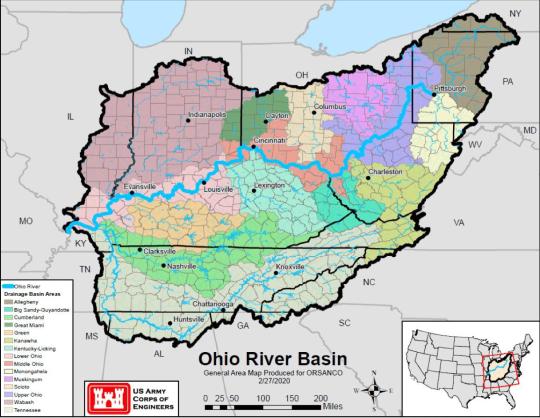#ohio river
Text
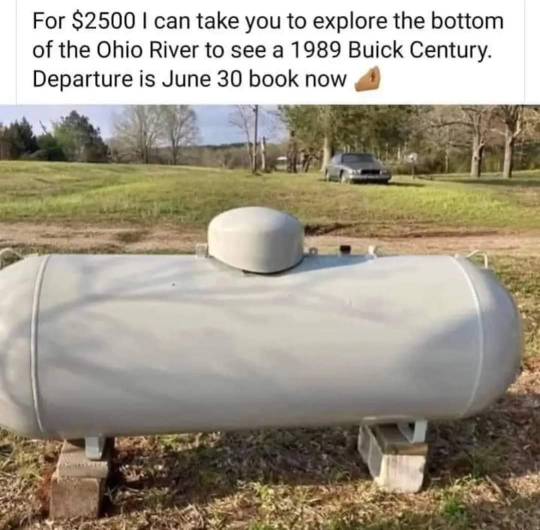
#lol#funny#memes#lol memes#funny memes#titanic#missing submarine#ohio river#irony#eat the rich#anarchy#anarchist#anarchism#socialism#communism
321 notes
·
View notes
Text

Oh, I know this one: Dead bodies, some fish, a shit ton of pollution, and my respect for Bill Clinton
172 notes
·
View notes
Text

Ohio River, Goshen KY - on a hot summer afternoon, was out biking along a trail.
#photographers on tumblr#original photography#b&w#b&w photography#landscape photography#kentucky#ohio river
30 notes
·
View notes
Text
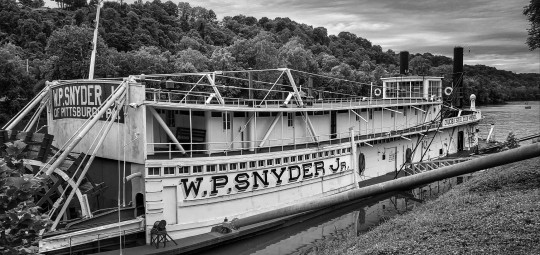
Parting the glistening currents of the Ohio River, her steam-driven sternwheel churns to the rhythm of water and machine. A world known only to her crew of 20, men working a six-hour watch, they labor to her melody.
The great river, known by the Iroquois as "O-Y-O," and later named, "Ohio," greets her haul with a loving embrace. Its sparkling waters living up to the French name, La Belle Viviere, meaning beautiful river. A beauty that now tenderly flows softly with the steam-powered towboat — the term "tow" referring to the lashed assembly of barges it pushes forward on her journey along the Midwestern coastline.
When her haul first graced the waters in 1918, she was originally named the W.H. Clingerman; however, after being purchased by the Crucible Steel Company in 1945, she was renamed for their company chairman, W.P. Snyder Jr.
For more than three decades, her frothy wake echoed along the beautiful river towns. Laboring day and night, feeding the U.S. economy — a nation blessed with perfect geography, as its great rivers unite as one, forming the mighty Mississippi on a voyage to the sea — moving barges loaded with coal, iron ore, and steel.
As steam-powered engines gradually surrendered to diesel, her life story finally concluded in 1954. While many of her sister boats would be scrapped, fate intervened in 1955 when the W.P. Snyder Jr was donated as a museum piece.
Photo: W.P. Snyder Jr at the Ohio River Museum, Marietta, Ohio.
By @aviationgeek71
#old boat#ohio river#ohio history#my photography#my photo#original photography#my writing#original writing
39 notes
·
View notes
Text
The EPA announced three additional carcinogenic chemicals have been detected in the Ohio trail derailment.
Vinyl chloride: a colorless gas that is used to make polyvinyl chloride (PVC) plastics and is highly flammable and decomposes to make toxic fumes. According to the National Library of Medicine, it is also carcinogenic and can cause other health issues.
Butyl acrylate: a clear liquid that is used for making paints, sealants and adhesives. It is flammable and can cause skin, eye and respiratory irritation.
Ethylhexyl acrylate: a colorless liquid used to make paints and plastics. It can cause skin and respiratory irritation and, under moderate heat, can produce hazardous vapor.
Ethylene glycol monobutyl: a colorless liquid used as a solvent for paint and inks, as well as some dry cleaning solutions. It is classed as acutely toxic, able to cause serious or permanent injury, and highly flammable. Vapors can irritate the eyes and nose, and ingestion can cause headaches and vomiting.
Vinyl chloride turns into hydrogen chloride when burned (which is what Norfolk did). When hydrogen chloride mixes with water (think the upper atmosphere), it turns into hydrochloric acid. This was the primary chemical in this spill.
The chemicals have, at this point, on February 13th, 2023, reached the Ohio River, which then flows into the Mississippi. Wildlife everywhere in Ohio and Pennsylvania are dying, and people are being told that it's okay to go home.
This tragedy happened because Norfolk Southern Railway has been cutting operation costs to a dangerous level. This is one of the things, in addition to NO SICK LEAVE for rail workers, that was being brought up when the rail unions were threatening to strike before Joe Blow busted it.
The Carmen, who have their own union and are responsible for safety checks, have had their inspection times reduced from the industry standard of three minutes per car to 90 seconds. Going over that time risks termination.
There was another derailment on December 2022 ALSO in East Ohio and ALSO with Norfolk Southern Railway, only that was just candle wax. 7 weeks later and this happens.
100 notes
·
View notes
Text
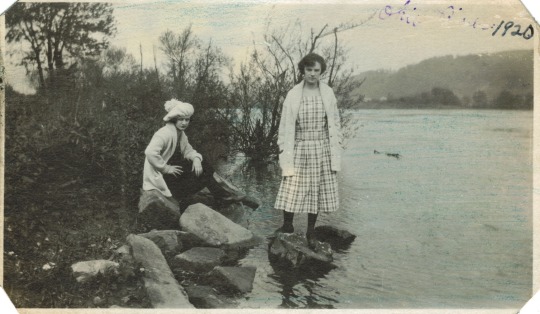
#1920#1920s#women#ohio#ohio river#people#found photo#antique#old photo#found photography#vernacular photography#vintage#river#nature#old photography#b&w#black and white#photography
10 notes
·
View notes
Text
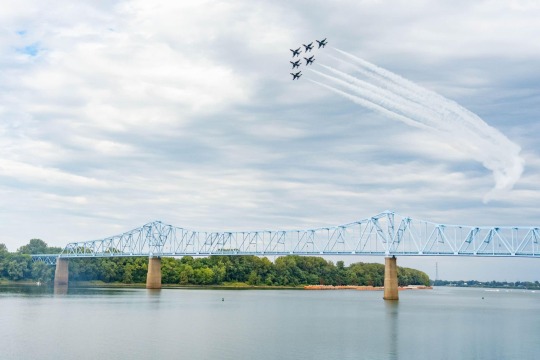
USAF Thunderbirds over the Owensboro Bridge
#USAF#Thunderbirds#F-16#Viper#Scenery#Ohio River#Owensboro Bridge#Blue Bridge#Landscape#Military aircraft#Fighter jets
31 notes
·
View notes
Text
This has been brushed under the table by Wall Street (who own Norfolk Southern) and the Ohio/Pennsylvania govts, but reporting on it because it's a disaster: As a result of rail corruption/mismanagement (and USgov thanos snapping the rail strikes), a Norfolk Southern chemical freight train was derailed and spilled its load on Feb 3 near East Palestine (a town on the very eastern side of Ohio), which then apparently exploded. [Apparently. Lots of claims going around, but I can't find a source.] They decided to burn the vinyl chloride to stop it from leeching into the environment further, because letting it leech into the air was better I guess. This is relevant for anyone living in Ohio, Pennsylvania, West Virginia, and potentially Western New York. The chemicals reported to be carried were Vinyl Chloride [carcinogen with a boiling point of 8F/-13C that releases dangerous gases into the atmosphere], Ethylene Glycol Monobutyl Ether, Ethylhexyl Acrylate [carcinogen], and Isobutylene. The train was 50 cars long.
Immediate effects have shown up in East Ohio and West PA, including reports of "acrid smells", as well as smoke clouds and fish, birds, and foxes turning up dead. Contaminants are confirmed to have reached the Ohio River and have leeched into the water supply of vulnerable towns in West Virginia. Local water sources and well water should be avoided and treated with scrutiny, as far as Eastern/southern Ohio, Northern WV, and Western PA. It is unclear what other water supplies have been contaminated, but veering on the side of caution for now is better - tests are still being taken and the situation is developing.
As a result of the burn, Phosgene gas and Hydrogen Chloride are spreading into the atmosphere. Hydrogen Chloride, now pumped into the air as a result of the burn, bonds with water vapor and turns into Hydrochloric Acid. This may cause acid rain. The wind is blowing west to northeast and affects Eastern Ohio, Pennsylvania and potentially, should it reach far enough, parts of Western NY (though it's unclear how far this is going to spread). This will affect people and animals over the long term on a scale comparable to 9/11 and some of the worst oil spills, and was entirely preventable had rail companies not cut corners on the operation and safety of their trains and train routes. Additionally, two more trains with hazardous material have derailed in South Carolina and Texas, though no known burns have occurred from those yet.
74 notes
·
View notes
Text

6 notes
·
View notes
Text
Here Are 17 Uncommon Curiosities Reportedly Found In The Ohio River
The Queen City, as Henry Wadsworth Longfellow famously wrote, sits “in her garlands dressed, on the banks of the Beautiful River.” Once claimed by the French and named by them exactly that: La Belle Riviere, the Ohio has been the soul and foundation of our city ever since the first houses went up, but our Beautiful River has also proved to be a weird and moody companion, coughing up a bizarre miscellany from time to time.
Alligators
In 1879, Dr. A. Jackson Howe procured a live, three-foot long alligator for display at the museum of the Cincinnati Society of Natural History. The reptile had been captured on the Covington shore, while several others were spotted frolicking in the Ohio River among some empty coal barges. Three years later, John Thornton found an alligator sleeping beneath the floorboards of his Newport icehouse. Charles Pitts of Covington lassoed a three-and-a-half-foot alligator from the Ohio River at the foot of Covington’s Main Street in 1870.
Bodies, Lots Of Bodies
Almost from the time Cincinnati was first settled bodies have been recovered from the Ohio River including suicides, victims of foul play and accidental drownings. Among the earliest casualties was Francis Kennedy, who operated the first ferry between Cincinnati and Northern Kentucky and who drowned while hauling beef cattle to Fort Washington. Over the years, the old newspapers printed hundreds of inquest reports, often directed toward ascertaining the identities of bodies found overnight.
Catfish Of Unusual Size
The Cincinnati Commercial Tribune of 3 February 1849 reports that Frederick Diserens, proprietor of the William Tell restaurant, and Colonel Josiah J. Stratton of the Fire Department, had shipped a “mammoth cat fish” to the Exchange Hotel in Philadelphia. The leviathan, caught in the Ohio River at Cincinnati, measured five feet, ten inches in length and tipped the scales at 158 pounds. Prior to its shipment east, the beast hung outside Diserens’ establishment on the south side of what is now Government Square. In 2009, two fishermen landed a blue catfish measuring four feet, six inches long and weighing 96 pounds within view of downtown Cincinnati.
Chemical “Slug”
The Ohio River, lined with heavily fertilized farmland and a multitude of manufacturing plants, is regularly listed as among the most polluted streams in America. Residents of a certain age will recall the great carbon tetrachloride “slug” of 1977. When a tank full of toxic “carbon tet” ruptured at the FMC Corporation facility in February of that year, it released 5000 to 6000 pounds into the Ohio River as a 50- to 60-mile “slug” of highly polluted liquid. Water purification systems up and down the river shut off intake valves until the “slug” passed.
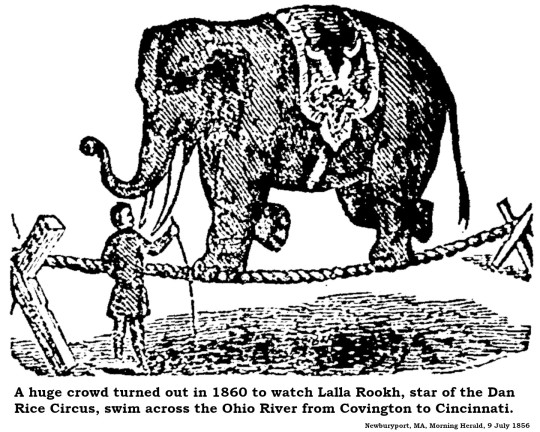
Elephant Bathing
All of Cincinnati – and Covington, too – turned out on the morning of 9 August 1860 to watch an elephant swim across the Ohio River. The elephant was Lalla Rookh, star of the Dan Rice Circus. Lalla Rookh had been, for the past decade, a highlight of Dan Rice's big-top extravaganzas. Billed as the “Pachyderm Princess,” she was famous for her tightrope act and she also danced, rang bells and fired a pistol. She was a huge draw and, according to the Cincinnati Enquirer, brought out a good crowd for her river bath, estimated between 15,000 and 20,000
Ghosts
No one ever solved the 1890 murder of Billy Fee, who was knifed and shot on the banks of the Ohio River near Lawrenceburg. Almost a year later a young man traveling by boat up the river past the murder scene cried out that he could see shadows on the darkened waters vividly recreating the murder scene. For years, residents of Lawrenceburg venturing near the river at night reported visions of the dreadful crime, accompanied by the sounds of shrieks and gunshots.
Giant Snakes
On 11 August 1849, a Clermont County “man of respectability” named John Wait swore to an affidavit in which he claimed to have seen a snake more than 30 feet in length on the banks of Hartman’s mill pond. A posse was assembled and searched all over for the beast with no results, even after draining the mill pond. Sightings, however, continued for the next decade. In 1858, the Cincinnati Commercial Tribune reported that the dam at Hartman’s mill had been badly damaged by a flood and the snake was assumed to have escaped toward the Ohio River. According to a 1940 article in the Cincinnati Post, the Cincinnati Zoo offered to help citizens near Gallipolis locate a snake estimated at 35 feet in length. Coincidence?
Green Clawed Beast
It was a sultry afternoon on 14 August 1955 when Naomi Johnson and some friends headed to the Ohio River at Evansville for a refreshing dip. While swimming just 15 feet offshore, something swam up behind Mrs. Johnson and grabbed her leg. She felt claws scratch her leg as the thing pulled her under the water. She began kicking her assailant and was pulled under a second time before her friends lifted her out of the river. Her left leg was extensively lacerated and bruised, with one mark distinctly hand-shaped. Mrs. Johnson claimed to have seen a UFO just before she was attacked, and there were several UFO sightings in the Evansville area around the time of the incident, leading her to believe an extraterrestrial origin for her attacker.
Kentucky Border
For most of our region’s history, the entire Ohio River belonged exclusively to Kentucky. That all changed on 21 January 1980, when the United States Supreme Court fixed the border between Ohio and Kentucky at the low-water mark of the river in 1792. With two centuries of dam construction and other navigational improvements, the Ohio River is significantly deeper and wider than it was in the 1790s. The border is now, in some cases, hundreds of feet off the Ohio shore.
Madonna’s Yacht
Rusting away in an Ohio River tributary just 25 miles downriver from Cincinnati is a 186-foot yacht originally known as the Celt but probably most famous as the USS Sachem among a variety of names acquired over its 120-year history. Thomas Edison used it for anti-submarine research. It ran out of New York as a recreational fishing vessel and served as a coastal patrol ship during World War II. After the war it hauled tourists around Manhattan. Robert Miller of Finneytown bought the yacht for $7500 in the 1980s and rented it out to Madonna, who filmed part of her “Papa Don’t Preach” video onboard. Miller hauled it upriver to its current resting place shortly after sailing a boatload of friends around the rededication of the Statue of Liberty in 1986.
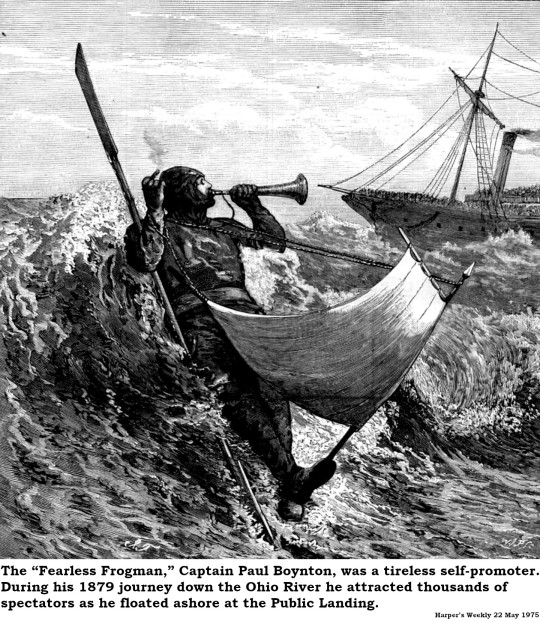
Man Afloat
On 11 March 1879, a crowd of fifteen thousand swarmed the riverfront to catch a glimpse of the “Fearless Frogman,” Captain Paul Boynton, as he arrived in Cincinnati while floating from Pittsburgh to Cairo in a buoyant rubber suit. Outfitted with sails and oars, Boynton’s “peculiar life-saving dress” allowed him to maintain speeds of five or six miles per hour on his downriver odyssey. That night, he attended a performance at the Grand Opera House on Vine Street and, being recognized, was called to the stage and compelled to give a speech.
Mud Mermaids
The Cincinnati Enquirer of 6 September 1894 reported two “nondescript creatures, horrible in appearance and strange in habits” at a sand bar in the Ohio River near Vevay, Indiana. The creatures appeared to be carnivorous, dining on fish and mussels plucked from the river. They were described as being yellowish in color, about five feet long, with webbed and clawed hands and feet. Their hairless heads had sharply pointed ears standing straight up. In the years since, the Vevay beings have been dubbed “Mud Mermaids.”
Octoman
Police dispatchers along both sides of the Ohio River were swamped with frantic calls from late January to early February 1959 as dozens of residents and travelers reported strange creatures emerging from the depths. Sightings were recorded from New Richmond to the Licking River bridge. One witness compared the critter to an octopus while others said it looked like an immense human, leading to the nickname Octoman. Panic spread, with one 11-year-old boy calling the Cincinnati Post to confirm his teacher’s story that green men were clambering out of the river in platoons of twelve. To add to the mystery, all the streetlights along Kellogg Avenue from Lunken Airport to Coney Island extinguished as the first reports came in. After a week, sightings abated and Octoman seemingly disappeared.
Petroglyphs
Just as the Ohio River slips across the state line from Pennsylvania, at the junction with Little Beaver Creek at East Liverpool, it covers a vast array of submerged designs carved into the rock. First recognized by French explorers in 1755, the display has been largely immersed in a much deeper river, only occasionally emerging into visibility in times of extreme drought. Hundreds of these Native American carvings were found for about 10 miles along the Ohio River from Midland, Pennsylvania through Wellsville, Ohio. The origin or date of the petroglyphs remains unknown and will likely never be determined.
Sea Lion
In May 1962 several people reported a strange beast frolicking in the Ohio River near the Fernbank locks. The animal was not large; maybe three feet in length, but it was unlike anything naturally associated with the wildlife of the area. An expedition organized by the Cincinnati Zoo discovered that the mysterious visitor was a sea lion named “Playful George” that had escaped from a menagerie in Huntington, West Virginia and made its way nearly 200 miles downriver to the Markland Dam. George was captured and quarantined at the Zoo before returning home.
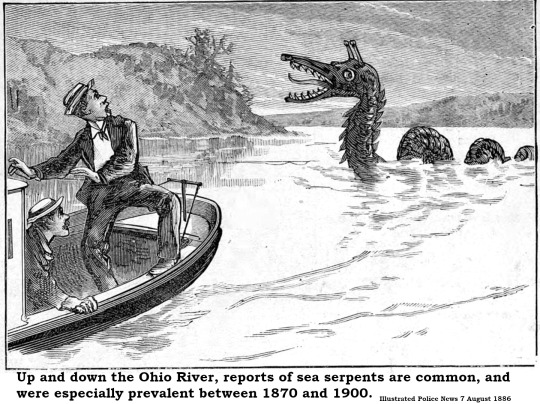
Sea Serpents
In the dim, pre-dawn light of Friday, 11 January 1878, Ben Karrick was driving his horse-drawn delivery wagon over the Roebling Suspension Bridge when he saw a most unusual sight in the Ohio River below – a sea serpent. He told the Cincinnati Gazette that the creature’s serpentine head protruded from the water some twelve or fifteen feet and it lashed the water into foam with its tail. Karrick told the newspaper that the beast made a noise similar to the deep lowing of a cow, interspersed with a loud hissing noise. A day previously, John Davidson, master of the Silver Moon steamboat, saw a nearly identical monster while docked at Vevay, Indiana. In July 1893, pleasure boaters near Blennerhassett Island saw “a monstrous submarine animal or serpent, with an immense head and staring, bulbous eyes” gliding alongside their boat. The witnesses estimated the critter at more than 10 feet in length.
Underwater Pedestrian
Newspapers around the nation carried the news in July 1878 that Captain John T. Guire, identified as “the celebrated submarine diver,” had entered into a wager that he would walk from Cincinnati to Cairo on the bottom of the Ohio River. Guire’s previous exploits in the Mississippi River at Saint Louis were cited as proof of his skill and determination. Although it was noted that Guire engaged in practice strolls near Cincinnati, it does not appear that the 500-mile underwater hike to Cairo ever materialized.
21 notes
·
View notes
Text






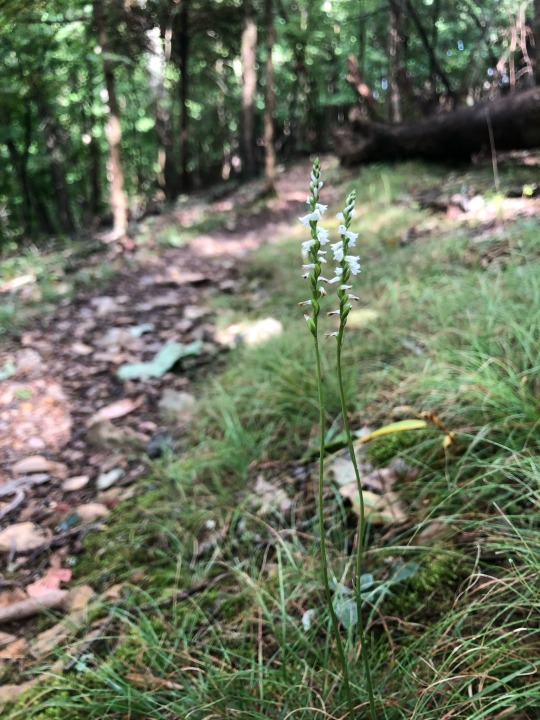


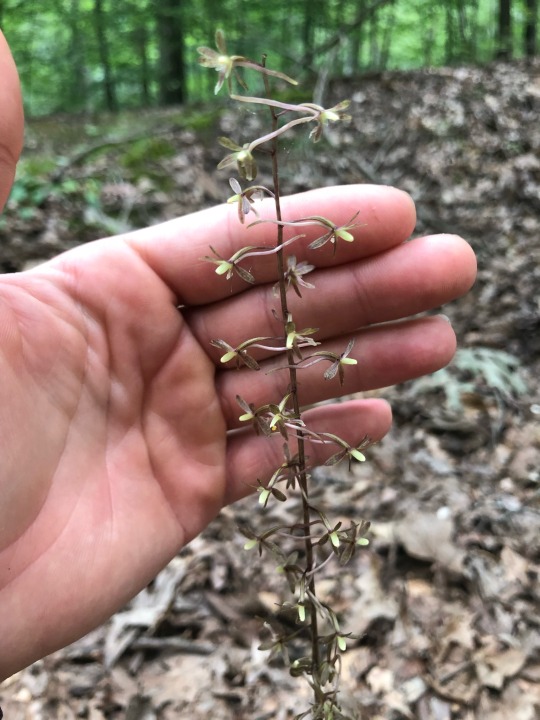
looking back at the year ~ August 2023
summer is for botanizing
warm up in the garden
runs inspired by orchid sightings
the lush green, and the warming sun
cool down walks with Toad
#nature#running#trail running#kentucky#native plants#orchids#crane fly#rattlesnake plantain#southern indiana#yarden#lobelia#black eyed susan#toad the dog#Ohio River#biking#raised beds#raised bed turned big ol flower box
8 notes
·
View notes
Text


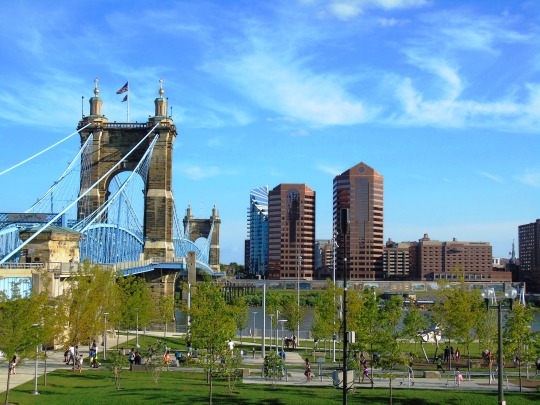
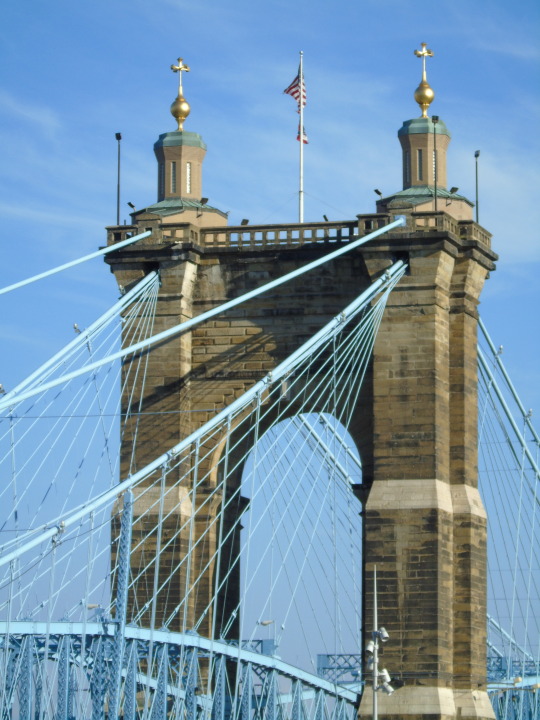

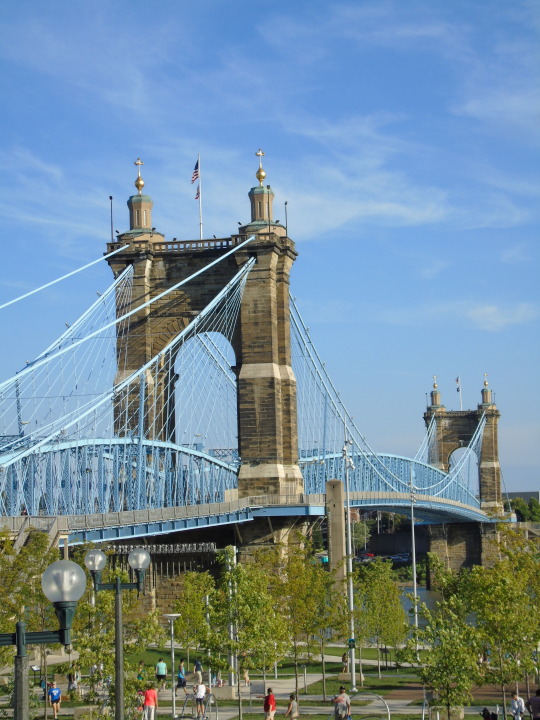


On December 1, 1866, pedestrians walked upon the Covington and Cincinnati Suspension Bridge, known locally only as “The Suspension Bridge,” for the first time.
#Covington and Cincinnati Suspension Bridge#1 December 1866#Cincinnati#USA#Ohio#Kentucky#Covington#Cincinnati-Covington Bridge#travel#John A. Roebling Suspension Bridge#John A. Roebling#architecture#cityscape#Ohio River#summer 2016#original photography#landmark#tourist attraction#anniversary#US history#vacation
7 notes
·
View notes
Photo

Ohio River, Prospect KY - looking across the river to Indiana
45 notes
·
View notes
Text

#east palestine#toxicity#contamination#ohio river#america is a failed state#america is a shithole country#america is a third world country#media blackout#media coverup
40 notes
·
View notes
Text
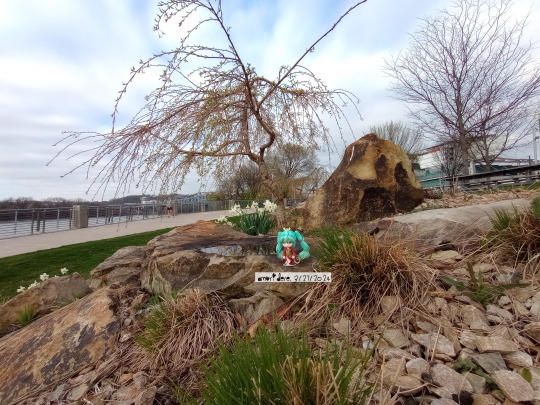

"Beauty in the (Zen) Garden"
Beauty with this mini zen garden. I might not take her out so much but she certainly matched this scenery.
#nendoroid#nendography#signatured#mobile photography#beauty looking back#hatsune miku#sunnie the pikachu#cincinnati parks#moto g stylus 2022#seldom seen#vocaloid#cincinnati#riverfront#ohio river
5 notes
·
View notes
